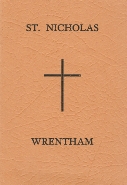

Copyright Wrentham Parish Council

Welcome to Wrentham

A HISTORY OF ST. NICHOLAS
WRENTHAM
In days before roads of any quality were made, the habitations of the peopte in Wrentham clustered round the Church.
The “new turnpike road”going through Benacre, (the A 12), was made about 1786, for the Ipswich Journal of the 27th May of that year records that one of the workmen found a bottle containing 920 silver coins. Since then the houses have been built around the “five cross ways”
In 1086 Wrentham had a population of 580, so that it is doubtful if there were six other places in Suffolk which were of more importance. Two Churches formerly stood in the village, one almost certainly on the site of the present Church. All trace of the other has been lost.
The unusually wide chancel, with no chancel arch, is evidently of the middle of the thirteenth century, and retains some of the original lancet windows, and a Priest’s doorway (now blocked up).
The south aisle was added in the fourteenth century, and the north in the early nineteenth. In the fifteenth century two windows (now in the modern north aisle) were inserted, and three windows in the chancel.
The tower, which is exceptionally fine, is evidently late fifteenth century. Around the base are panels depicting hearts surrounded by crowns of thorns, and flanking the west door are canopied niches, the figures from which may well have been removed and destroyed by William Dowsing on the 26th August, 1660 when it is recorded that he destroyed “twelve superstitious pictures” In 1804, when invasion was threatened by Napoleon l, it was used as a signal tower, for it commands an extensive view of the coastline. There are six bells, the “second” is the second earliest known one made by John Clark, and is dated 1606.
The eastern end of the south aisle was formerly a chapel and still retains its piscina, and at the angle of the wall is a recess in which probably stood an image of St. john, as at one time there was a Guild of St. John the Baptist in Wrentham Church. It has recently been restored as a chapel and is also used as a children’ corner by the Sunday School. A stained glass panel, now mounted here, was made by Royal William Lilly of Wrentham in 1850.
The old font, now in the north aisle, was discovered in the Rectory garden.
The plate includes a chalice of Norwich make dating from about 1660, and the registers date from the reign of James I, 1602.
The short stall ends are of Lignum Vitae grown in Goa, brought to Lisbon, placed in the King's Chapel at Belem, and from there placed in the chancel of Wrentham Church.
In 1842 the fine old Jacobean pulpit was sold, purchased by the Reverend J. Browne, and placed in the Congregational Church, so that those who officiate there occupy the same pulpit from which Thomas King was ejected in 1662.
There is a stone altar slab, now mounted in an oak frame. This was found in the centre aisle of the nave, where it had been used as a burial stone. It was restored to its former place and used again on the feast of St. Michael and All Angels, 1931.
The ancient piscina in the sanctuary was discovered by the Rector in 1937 (Canon F. R. Bonsey) behind some wooden panelling. The banner or cross cupboard near the south door was also discovered at the same time and restored to its original use.
There is a fine piece of fifteenth century glass in one of the windows of the north aisle, representing St. Nicholas, to whom the Church is dedicated, with his staff and mitre, and a golden haired child. Below this is another beautiful piece of old glass believed to be of foreign origin.
The brass in the chancel floor is of Ele Bowet, dated 1400, below it is a Latin verse
Ele Bowet grata mulier jacet hic tumulata
Roberti nata fuit Ufford hec vocitata
MC quater in hijs februari septim’idus
Vivat in eternis p(er)agravit tunc super sidus.
This has been translated as:
Ele Bowet beloved wife lies buried here
She was born of Robert Ufford and was called from here
This seventh day of February 1400
May she live eternally travelling above the stars.
Further details, and her genealogical table are avail-
The brass of Humphrey Brewster, the builder of Wrentham Hall, is mounted in the north wall of the chancel. He died in 1593, and the brass is an excellent example of the military costume of the Elizabethan period.
From information contained in this booklet:—-



| Information |
| Map |
| Photos |
| Sports & Recreation Facilities |
| Local Attractions |
| Wrentham, Massachusetts |
| church |
| AboutWrenthamVillageHall |
| What's On |
| Booking Information |
| Village Hall History |
| The Windmills of Wrentham |
| Old Photos of Wrentham |
| Wrentham Celebrations |